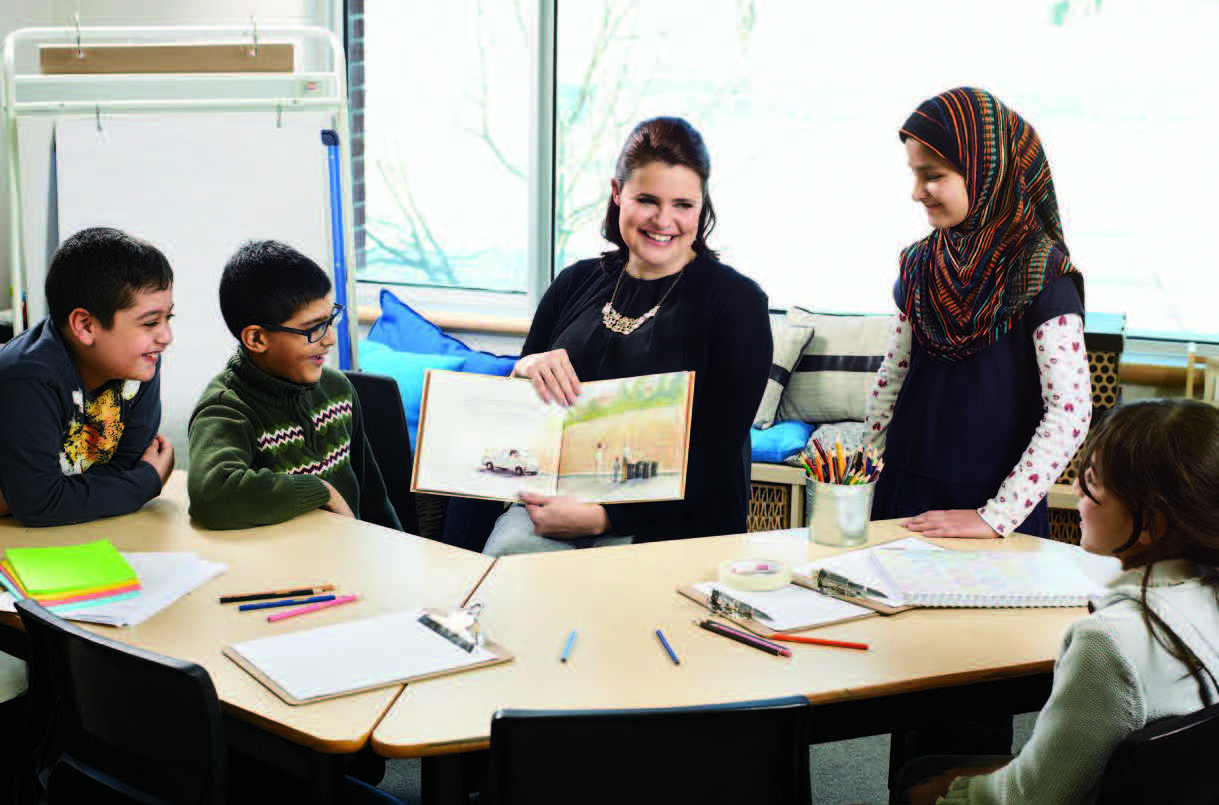Share this page

Tracey Tinley, OCT, helps students find their greatness by applying authentic learning from their everyday lives.
By Trish Snyder
Photos: Matthew Liteplo
To view our Great Teaching video archive, visit oct-oeeo.ca/1KWel5r
It’s days after the federal government’s swearing in on Parliament Hill when Tracey Tinley, OCT, invites her Grade 4/5s to a less formal gathering on the carpet at Berrigan Elementary School in the Ottawa-Carleton District School Board. “Let’s talk about swagger,” says Tinley. It’s a Language Arts lesson about writer’s craft but she gets their attention by name-dropping Justin Bieber, who hired a “swagger coach” to learn how to “look cool.” Instead of hairstyles and clothes, she wants students to find and use swagger — shiny words, powerful phrases — to analyze a non-fiction picture book called The Boy Who Harnessed the Wind.
“I found this last night,” she says, cueing YouTube. “I think you’re going to find it inspiring.” It’s a short documentary about William, the hero of their book. When drought, hunger and poverty forced the 14-year-old to quit school in Malawi, he built a windmill that introduced electricity — including water to sustain crops and light to study after dark — to his family’s home. Tinley knows it’s one thing to read about a teen who overcomes adversity, but when the students see TV cameras show up at William’s dirt house they get the gravity of their hero’s accomplishment.
“Now let’s play a game: What do you see, what might it mean?” Tinley asks, holding open the book to an illustration of the village’s sun-scorched landscape. The veteran teacher knows every class contains a variety of reading abilities, but every child can understand pictures: she turns this illustration study into a game to help them analyze a book’s deeper meanings (recommended books for this activity on p. 25). “I’m seeing some interesting stuff in these pictures and I’m curious to know what you think.” She’s challenging them to next-level thinking, yet her genuine respect and enthusiasm draw out immediate responses. A 10-year-old notices that the ground looks like crumpled paper: “Maybe that means nothing is going well in the village because it’s so hot and dry.” Another points out that the sun has a circle around it. “It looks like a light bulb. Like there’s going to be a huge idea coming.” Tinley is beaming at their interpretations as she asks them to spend 10 minutes writing about an illustration from the book. One girl wails when it’s time to pack up: “I have so many ideas, my head’s about to explode!”

Tinley was once the kind of teacher who plotted out lessons a week in advance. Now, she experiments more, using her classroom as a lab to analyze what’s working, what’s not and figure out how best to respond to her students’ needs.
Former Berrigan principal Jill Cutler, OCT, became a fan when she soon noticed two things after working with Tinley: the quality of student work on display outside her classroom and children wearing looks of reverence as they passed their teacher in the hall. After watching her in action, Cutler began tinkering with the teacher’s schedule. Instead of a homeroom, she assigned Tinley to teach various subjects — such as drama, reading and math support — to a variety of classes. “I needed to have this teacher exposed to as many students as possible,” says Cutler, who was so impressed with the elementary teacher’s positive impact that she nominated her for a Prime Minister’s Award for Teaching Excellence. In 2014, Tinley won, and was seconded part-time to write teacher resources for The Critical Thinking Consortium (tc2.ca).
Since Tinley believes students learn as much from each other as from her, she sets a positive classroom tone with accountable talk. When someone is speaking, students lower their hands and listen. When group discussions fizzle — as students bounce random ideas around the room — she teaches the art of give-and-take in conversation. Before long, they’re using phrases such as, “I can add to that,” or “I respectfully disagree and here’s why.”
“To be able to reiterate a point is a skill,” says Tinley. “When students can listen to someone speak, have differing opinions, then share their insights respectfully — to grow the learning (rather than shut it down) — that’s more than just teaching social skills. I do this to show them that we’re all in this together, we’re all bringing something to the lesson.
”Tinley also has an extraordinary gift for spotting authentic learning in everyday life. After the 2012 Olympic Games, she plastered her class door with
“Find Your Greatness,” the slogan from that summer’s Nike campaign. The ads fuelled activities in writing, inferential thinking and media, while the be-your-best theme resonated in a class with more special needs children than usual. “I find it difficult to get excited about a dictation,” admits Tinley. “But I feel lit up when I’m teaching from real life because the students give so much back — my engagement and enthusiasm rubs off.” At the end of the year, every child grinned when they noticed she’d updated the door: “We Found Our Greatness.”
The Nike unit was so effective that Tinley shared the lessons at the pay-as-you-go professional development workshop that she runs. When one teacher asked why she’d want to let others use her lessons, Tinley shrugged. “There aren’t many years where I’m dragging myself around feeling unappreciated by students. Seeing them work so hard inspires me to do the same for them — I don’t want to be the only one who has this experience as a teacher.”
“If students feel like it’s possible to be successful, there’s nothing they won’t do for you.”
Tinley doesn’t get podium-quality results by handing out photocopied rubrics. When she asked a previous class of Grade 3/4 students to produce a book trailer using the Animoto slideshow app (animoto.com), she started by showing the best one she could find on YouTube. They discussed what made the trailer effective, such as questions that keep the viewer interested and background music with lyrics that support the book’s message. “Actively articulating what excellence looks like allows them to interpret and internalize it,” explains Tinley. She recorded their observations on an anchor chart, which acted as a reminder during the creative process. In other words, Tinley invites children to collaborate in creating criteria. The trailers were so good that she invited parents to an in-class screening. (See the trailers at mrstinley.weebly.com.)
As a math support teacher for Grade 3/4, it’s easy to see why Tinley embraces three-part problem-solving during a lively afternoon class at Berrigan. First, she spends five to 10 minutes explaining the task — draw bar graphs comparing life expectancies of four animals. For Phase 2, she sends them off in pairs to work things out. Through the talking, counting and scribbling, they bump into a problem: the graph paper was deliberately too small for a 1:1 scale. During the final step, she bundles the learning (you had to scale the graphs by 2, 5 or 10), by asking three groups to explain their work in their own words. Tinley compliments one group on their messy graph: “This is the reason we use marker — seeing mistakes is the most exciting part! When you cross something out, it means you’ve learned something.” She credits this method of problem-solving with cultivating more than just math knowledge. “It highlights what it means to be a learner — not to know the answer, talking and working it through, trying a variety of alternatives. That resilience is a life skill.”
Another trick she uses to extract excellence? Giving and taking feedback. During a unit on guerrilla poetry (bringing poetry to the public in unconventional and surprising ways), she challenges students to look for the extraordinary in the everyday, arranging a class visit to the school boiler room. Because the writing is short, she gives quick, often verbal feedback. In a very tangible way, the students witness the power of breaking a phrase differently or isolating a single word on its own line. “If students feel like it’s possible to be successful, there’s nothing they won’t do for you,” she says. Feedback also flows the other way. Tinley no longer fills her day planner a week ahead because much of what she does one day depends on what happens the day before. “What I want to cover doesn’t matter,” she says. “What makes teaching so powerful is taking cues from their work, which tells me where I need to go.”
Having this award-winning teacher in Grade 5 was a turning point for a boy named Ethan. His mother, Angelika da Silveira, still remembers when her introverted son burst into their home and shared his boiler room poem. Next, he requested poetry books for bedtime reading. “Mrs. Tinley encouraged a child who couldn’t stand literature to want to be an author. Two years later, he’s still reading poetry and coming up with little rhymes,” says da Silveira. “She taught my son to look at the world differently. She planted a seed and it’s still growing.”
The OCT featured in this department has been recognized with a national teaching award and exemplifies the high standards of practice to which the College holds the teaching profession.
While supporting various schools in the Ottawa-Carleton District School Board as a literary coach, Tracey Tinley, OCT, discovered sophisticated picture books for Grades 4–6. Read aloud by the teacher, the books invite deeper thinking about themes, meaning, symbolism and point of view. She recommends these seven picks:
The Caged Birds of Phnom Penh
By Frederick Lipp
Illustrated by Ronald Himler
An exploration of hope and dreams set in Cambodia — despite despair and treachery.
The Red Tree
By Shaun Tan
The use of metaphors help paint a haunting but hopeful view of childhood depression.
A Day’s Work
By Eve Bunting
Illustrated by Ronald Himler
A grandfather teaches his grandson about honour after they get caught in the boy’s lie.
14 Cows for America
By Carmen Agra Deedy
Illustrated by Thomas Gonzalez
The true story of a Masai village in Kenya that offered foreign aid to the U.S. after 9/11.
The Dream of the Thylacine
By Margaret Wild
Illustrated by Ron Brooks
A 130-word lament about animal extinction — the story of the last remaining Tasmanian tiger.
Wilma Unlimited
By Kathleen Krull
Illustrated by David Diaz
Meet the first female sprinter in the U.S. to win three gold medals in a single Olympic Games.
The Boy Who Harnessed the Wind
By William Kamkwamba and Bryan Mealer
Illustrated by Elizabeth Zunon
A 14-year-old overcomes staggering adversity to bring electricity to his village.